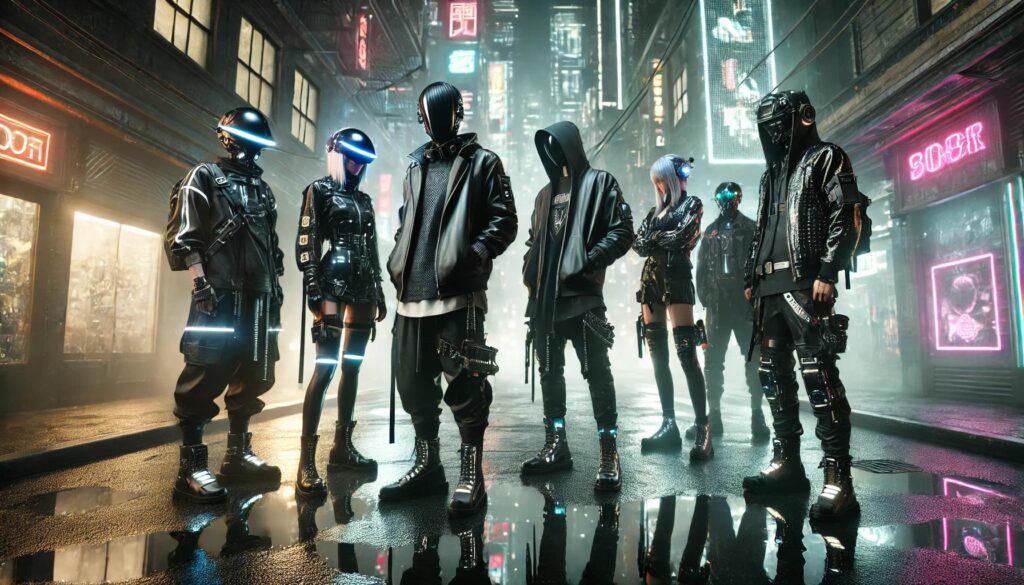In the realm of fashion, trends come and go, but some subcultures make a permanent mark, leaving an imprint that continues to evolve and inspire new generations. One such phenomenon is cyberpunk fashion, a style that blends futuristic aesthetics with a gritty, rebellious edge. Rooted in science fiction, technology, and dystopian visions of the future, cyberpunk fashion is not just about what you wear; it’s about making a statement. It’s the embodiment of resistance, the celebration of individualism, and the vision of a world where high-tech meets low life. In this blog, we’ll explore the origins, elements, and modern interpretations of cyberpunk fashion and how it merges futurism with street style in a way that has captivated the hearts and wardrobes of many.
The Origins of Cyberpunk Fashion
Cyberpunk fashion originates from the 1980s subgenre of science fiction known as cyberpunk, a movement characterized by its dark, dystopian visions of the future, where mega-corporations dominate society and technology plays an invasive role in everyday life. Novels like William Gibson’s Neuromancer and movies such as Blade Runner and The Matrix popularized this aesthetic, portraying worlds where the line between man and machine is blurred, and societal decay is omnipresent. Cyberpunk fashion, therefore, emerged as a visual expression of these dystopian futures—gritty, rebellious, and deeply connected to the idea of a tech-driven society.
This fashion trend is often defined by its blend of punk attitudes and futuristic, tech-inspired elements. It rejects the glossy, perfect visions of the future often seen in utopian sci-fi and instead embraces a world where technology is worn like armor, protecting individuals from a society that is increasingly harsh and impersonal. This ethos is expressed through sharp contrasts in fabric, the use of industrial materials, and the layering of complex, utilitarian designs.
Key Elements of Cyberpunk Fashion
Cyberpunk fashion is unmistakable due to its distinctive elements that merge functionality with a cutting-edge aesthetic. Here’s a breakdown of the core features that define this subversive style:
1. Dark and Monochrome Color Palettes
Cyberpunk fashion heavily favors darker tones—black, charcoal, and various shades of grey are dominant. These colors symbolize the dystopian and often bleak settings of the cyberpunk narrative. However, vibrant neon colors like electric blue, pink, and green are often used as accents, mimicking the glow of neon cityscapes in a futuristic urban environment.
2. Futuristic Tech-Inspired Details
Incorporating technological elements is a hallmark of cyberpunk fashion. Metallic finishes, LED lights, augmented reality-inspired visors, and futuristic eyewear are key features. This tech-wear aesthetic gives a nod to the integration of humans with machines—a core theme in cyberpunk culture. Often, these pieces have a functional purpose, such as glowing LED masks or jackets equipped with light-reflective materials that react to environmental changes.
3. Punk Influence
At its heart, cyberpunk fashion retains the rebellious spirit of traditional punk. From torn clothing and leather jackets to combat boots and heavy metal accessories, the punk influence reflects defiance against authority and corporate control. Spiked collars, chains, and oversized hardware give wearers a tough, “don’t mess with me” look that fits perfectly with the cyberpunk narrative of resistance against oppressive systems.
4. Utilitarian and Tactical Wear
Cyberpunk fashion also embraces functionality. Tactical vests, multi-pocket cargo pants, harnesses, and belts all serve a dual purpose—both practical and aesthetic. These elements align with the idea of surviving in a chaotic, dystopian world, where fashion must serve a purpose beyond mere decoration. The influence of military and survivalist gear is unmistakable, blending with the high-tech components to create a style that’s as practical as it is visually striking.
5. Gender Fluidity
In line with cyberpunk’s rejection of societal norms, gender fluidity is a key aspect of the fashion. Outfits are often androgynous, with sharp lines, boxy silhouettes, and oversized clothing. This lack of traditional gender boundaries speaks to a future where identity is more fluid and individuals express themselves freely through their clothing, irrespective of conventional gender roles.
Cyberpunk Meets Street Style
In recent years, cyberpunk fashion has found a new home in the world of street style. The futuristic, rebellious ethos of cyberpunk has seamlessly merged with the urban grit and casual cool of streetwear, creating a hybrid look that appeals to fashion-forward individuals. Major fashion houses and independent designers alike have begun incorporating cyberpunk elements into their collections, offering a high-fashion take on the street-ready cyberpunk aesthetic.
1. The Rise of Techwear
Techwear is perhaps the most obvious intersection between cyberpunk and street style. Techwear focuses on high-performance, functional clothing that is designed to withstand the elements while looking sleek and modern. Influenced by cyberpunk’s utilitarian side, techwear incorporates waterproof materials, breathable fabrics, and modular designs that can be customized to the wearer’s needs. Brands like Acronym, Stone Island, and Nike’s ACG line have championed this look, making it popular with urban dwellers who want their clothing to be both stylish and practical.
2. Cyberpunk in High Fashion
Fashion designers have also embraced the cyberpunk aesthetic on the runway. Brands like Balenciaga and Alexander Wang have incorporated futuristic, industrial elements into their designs, often featuring oversized silhouettes, robotic textures, and dystopian themes. These collections combine high-end luxury with a cyberpunk attitude, presenting a vision of the future that is both glamorous and rebellious.
3. DIY and Customization
True to its punk roots, cyberpunk fashion encourages a do-it-yourself attitude. Street style icons often customize their own pieces, adding patches, LED lights, or even 3D-printed elements to their outfits. This DIY spirit not only makes the style more accessible but also reinforces the idea that in a cyberpunk world, you’re responsible for crafting your own identity—often literally.
Cyberpunk in Pop Culture
Cyberpunk fashion has also gained mainstream attention thanks to its presence in pop culture. Video games like Cyberpunk 2077 and films like Ghost in the Shell and The Matrix have solidified the cyberpunk aesthetic in the public consciousness. Characters from these works sport iconic cyberpunk styles, from long leather trench coats and futuristic eyewear to neon-lit body modifications. These visual representations have inspired fans to adopt elements of cyberpunk fashion in their own lives, fueling the trend’s growth.
Moreover, music genres like synthwave and industrial, which often accompany cyberpunk narratives, have embraced the aesthetic, with musicians donning cyberpunk-inspired outfits for performances and music videos. This cross-pollination of fashion, music, and media continues to push cyberpunk style into the cultural mainstream.
Conclusion:
Cyberpunk fashion represents more than just a clothing style—it’s a vision of the future, one where individualism and rebellion take center stage. As technology becomes more integrated into our daily lives, it’s no surprise that cyberpunk fashion continues to grow in popularity. From techwear enthusiasts to streetwear lovers, people are drawn to this blend of futuristic function and rebellious form. It’s a style that looks to the future while remaining grounded in the realities of urban life.
As we move further into a world defined by technological advancements, environmental challenges, and shifting social norms, cyberpunk fashion may evolve, but its core message will remain the same: resist conformity, embrace technology, and never be afraid to stand out. The future may be uncertain, but in the world of cyberpunk fashion, it’s also undeniably cool.

